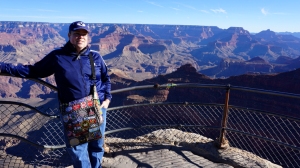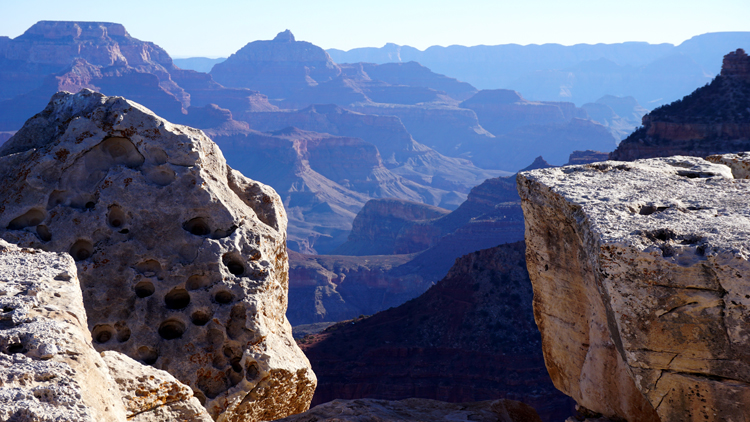How does one describe the Grand Canyon? Words fail and images, no matter how spectacular, only capture a minute glimpse of the majestic work of creation. I will do my best to share my experience through both word and image, but to truly understand you must go yourself and be swallowed by the striated walls as millions of years rise above you. You must find your way to an outcropping of ancient stone in the midst of the vast abyss. You must visit yourself to feel the greatness and be overwhelmed by the sheer beauty, magnanimity and serenity no other place can share in quite the same way.
I had been to this UNESCO World Heritage Site twice before. The first time was in February more than 15 years ago while touring with the Texas Boys Choir. We stopped by the South Rim at Grand Canyon Village for a brief visit. It was cold and icy, and we didn’t have time to do more than look over the most gazed-upon stretch and hit up a gift shop before getting back on the bus and heading on our way.
The second time was 12 years ago with my family. We spent a little more time at the South Rim and took one of the shuttle buses to an overlook or two towards Hermit’s Rest before we too got back in the vehicle and continued on our journey.
As they say, third time’s a charm, and it was. This time my visit was still short compared to the vastness of this wonder, but I got to experience it in my own way and time. I looked over the rim from hundreds of viewpoints and went more than 1,000 feet below the out onto a butte that extended far beyond the rim toward the river. I found myself alone at times on deserted trails where I could stop and breathe it all in with all my senses.
I explored the shapes of the trees and the pondered the changes in how the canyon has formed over millennia. I paused to listen to the wind and the rushing waters below. I felt the power of this treasure and communed with its creator while surrounded by the hallowed walls.
South Kaibab Trail
 Arriving early in the morning, I parked near the visitor center and made my way first thing to the rim at Mather Point, named after the first director of the National Park System. It was cold with a strong chilly wind blowing by, but the view was spectacular right from the get go. This was just dipping my toes in the water to test my senses before taking the plunge, which I did down the South Kaibab Trail.
Arriving early in the morning, I parked near the visitor center and made my way first thing to the rim at Mather Point, named after the first director of the National Park System. It was cold with a strong chilly wind blowing by, but the view was spectacular right from the get go. This was just dipping my toes in the water to test my senses before taking the plunge, which I did down the South Kaibab Trail.
A shuttle bus takes hikers to the trailhead near Yaki Point. Once there I began the descent with a dozen other trekkers. We split up rather quickly as some powered their way down and others like me took time to take in every vista at every turn. Being on the South Rim, the upper part of this trail is in shadow for much of the day this time of year, so it was a little cold on the way down the steep switchbacks before taking the first leg out toward the inner canyon.
The first pit stop on this particular journey is at Ooh Ahh Point where people are literally saying to themselves ooh ahh because this is the first time they are truly in the midst of the canyon and not just looking down from the edge.
I went down to the next pit stop at Cedar Ridge. All of the trial information said that beyond this point was “very difficult” and to this point was just “difficult.” So, I planned not to go beyond to the end of the recommended day hike at Skeleton Point. However, after completing the hike I did, I really feel I could have done the next leg and been fine, but I wouldn’t have had the time or energy to experience the rest of what I did that day.
At Cedar Ridge, I walked all the way out the end of the ridge and sat on a rock with my legs dangling over the edge as I listened and pondered and snacked and rested and oohed and awed and just wanted to sit there all day watching the ravens soar and the hikers climb and the mules clamber. But, alas, I didn’t with no regrets because of the rest of what I saw that day.
The Village
After slowly reemerging at the trailhead just before a train of mules, I took the shuttle to Yaki Point and gazed mesmerized once again before shuttling back to the visitor center and transferring to the village shuttle.
I didn’t want to spend much time in the village because I knew it would be crowded. I was right. There were actually moments when I was reminded of one of my worst (also best) days in China at Huangshan, a national park, on a holiday. However, for those truly interested in National Parks or architecture then a trip to the village is a must.
The whole village has been designated a National Historic Landmark with many of its individual buildings also honored with this designation including Charles Whittlesey’s El Tovar Hotel, the train depot, Lookout Studio, Kolb Studio, Mary Jane Colter’s Hopi House, Verkamp’s, and a few more. Having just completed Ken Burn’s National Parks documentary, I was familiar with the story of some of these historic structures and was intrigued to see the location of the fascinating stories.
Hermit’s Rest
 At the far end of the Village is another shuttle stop where you can catch a bus to the furthest developed South Rim stop within the park—Hermit’s Rest. I decided to take the shuttle all the way to the end of the line and hike back a couple of stops before riding back to what a ranger told me would be a great place to watch the sunset. So, I set out riding the red line to a quirky little building that gives this point its name.
At the far end of the Village is another shuttle stop where you can catch a bus to the furthest developed South Rim stop within the park—Hermit’s Rest. I decided to take the shuttle all the way to the end of the line and hike back a couple of stops before riding back to what a ranger told me would be a great place to watch the sunset. So, I set out riding the red line to a quirky little building that gives this point its name.
This is one of a few buildings designed by Mary Jane Colter, a wonderful architect who understood organic architecture and honored historic southwestern architecture. Hermit’s Rest, a historic tourist destination, was designed to look like a hermit built it, and it does! Using stone from the site and integrating the structure into the landscape it has a charm all its own.
From this end-of-the-line I walked the rim trail back a couple of stops and couldn’t believe my eyes at every turn and twist and bend. There is a paved trail here, but I noticed an unpaved trail closer to the rim. That is the trail I took as it meandered through the trees with spectacular views of the canyon and river as the sun dipped lower toward dusk.
I was the only one on the trail for much of the time, and it was super peaceful. I felt as if I had the whole canyon to myself. If it weren’t for the occasional shuttle going by in the distance, I would have felt like I was hiking in a completely unvisited location far away from any civilization.
Well, eventually I found my way to Hopi Point where I was told I would have a fantastic sunset viewing–so was everyone else. I felt like half the village was there. I waited patiently though and chatted with an Australian couple while the sun finally kissed the horizon and decided to take its romance somewhere a little more private.
That’s when the sky started singing and dancing with color. Wanting to see one more viewpoint before getting back on the final shuttles returning to the village, I hurried down the trail to Powell Point where I found a memorial built to John Wesley Powell who mapped the Grand Canyon while exploring and mapping much of the wild, untamed west.
I found my way back to the shuttle transfer to get back to my car by the visitor center as dark took hold very quickly. Because of the altitude of the rims and other factors, the moon didn’t immediately rise to visibility after it got dark. So, when I arrived at my parking lot I was overwhelmed by the glorious night sky.
Far away from any real cities or other major light pollution and not a cloud in the heavens, the universe displayed itself in all its glory that the naked eye could perceive. I couldn’t pass up this moment, so I left the soft glow of the parking lot for a few more minutes and made my way back to the rim just a hundred yards away. I wasn’t prepared for this and couldn’t capture it with anything but my mind. This was beauty. This was magnificence. This was glorious. The only words to use after such a sight are amen, amen, and amen.










My World Heritage Adventures | Adventure Patches
[…] Grand Canyon National Park […]